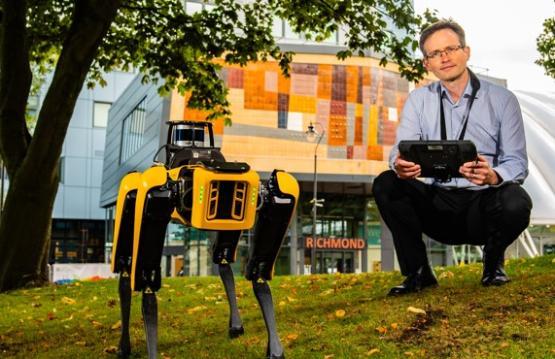University commended by AHRC for its cultural impact
Higher education funding body the Arts and Humanities Research Council (AHRC) – part of UK Research and Innovation (UKRI) – has commended the University of Bradford for demonstrating real-world impact following a £7m investment in cutting-edge technology.

A large part of that work revolved around the creation of the UK's first brick-for-brick digital replica of a city centre., otherwise known as Virtual Bradford.
The University was awarded successive rounds of infrastructure funding to invest in technology for archaeology and digital heritage applications that have been put to contemporary uses.
This includes cross-sectional imaging for object-based capture, that has been used with the extensive human bioarchaeology collections within the School of Archaeological & Forensic Sciences and most recently the iconic Cottingley Fairy cameras from the collections of the National Science and Media Museum which were scanned to show their internal workings.
Investment in vehicle-mounted 3D mapping cameras and scanners (the first of their kind in the UK) have been used with Bradford Council to extend the reach of Virtual Bradford - a digital twin that now includes coverage of Bradford city centre, Saltaire UNESCO world heritage site and the city's Southern Gateway.
The AHRC grants were part of its Capabilities for Collections scheme, known as CapCo and a related scheme CResCa (Creative Research Capability). The AHRC commended the University of Bradford as part of its ‘World Class Labs’ initiative, recognising the University’s role as strategic partner with #Bradford2025 UK City of Culture.
The University’s Visualising Heritage team have also used this mobile mapping infrastructure to replicate their work as part of AHRC’s commitment to UK-Ireland collaborations in the Digital Humanities, with input from Leica Geosystems to 3D capture the Irish Walled Towns of Kilmallock (County Limerick) and Derry (the first UK City of Culture – part of which is shown below) and as part of international research in support of the creative economy.
Professor Smith has written a blog summarising the impact of AHRC’s CapCo and CResCa investments as part of National infrastructure funding. He said: “ARHC Grants have funded a whole host of archaeological inventions, kit and equipment that is really taking the University of Bradford’s archaeology to a new level.
Professor Andrew Wilson, from the School of Archaeological and Forensic Sciences at the University of Bradford, said: “This is a tremendous investment, not just for the University of Bradford, but for the national capability. With AHRC funding, we now have a range of transformative digital technologies that underpin our research.
“It’s about 3D capture, it’s about the digital storage research infrastructure that helps the different tools, the different techniques that allow us to build meaning from objects, right the way through to buildings and cities.
“A digital twin of the city, which this funding helped support, enables us to make data-driven decisions.”
Adrian Walker, from Bradford Council, said: “For us as a council, it might be to visualise flooding, air quality, but also particularly things about heritage buildings and the impact of development on heritage.
“One of the best uses of the digital twin will be the management of the Saltaire World Heritage site and relating that to potential development around Saltaire and also the management of the parks and gardens.”
Real world impact
The University of Bradford and its School of Archaeological and Forensic Sciences have long focused their research activities on how technological innovation can influence policymaking and benefit society, securing the prestigious Queen’s Anniversary Prize in 2021.
One example of this has been to partner with the local authority to capture local heritage buildings at risk of being lost, which in turn led to the development of a digital twin for the city that allows residents to experience the city in novel ways through immersive technology.
Through the use of this digital technology, people are able to virtually experience hidden heritage locations and consider other heritage assets, including industrial heritage buildings, that are too damaged to be visited or have limited accessibility.
This promotes reflection on the use of heritage for wellbeing and signposts narratives that connect people, heritage and place, whilst also advocating active travel among residents of Bradford and visitors from outside the city.
World Class Labs
This research has been made possible through infrastructure investment as part of the UKRI Arts and Humanities Research Council’s World Class Labs programme, supporting the upgrade of the UK’s creative and heritage facilities. This funding has helped research organisations like the University of Bradford maintain and improve our facilities, laboratories and digital resources. World Class Labs is a scheme run by UKRI across eight research entities, with two of those schemes run by AHRC, one of which is CapCo. The funding has provided cutting-edge research facilities to support research and development, skills and growth in the cultural and creative economy.
Bradford 2025
The University of Bradford is strategic partner, alongside Bradford Council and the City of Culture team, seeking to ensure the success of Bradford 2025 and its legacy. This entails both strategic-level cooperation and support towards major infrastructure projects within Bradford. The university is planning to offer its facilities as fringe venues for immersive experience and other cultural engagement activities. To deliver on these aims, a member of staff from the School of Archaeological and Forensic Sciences has been seconded two days a week to be embedded with the City of Culture team and facilitate the strategic partnership with the university.

